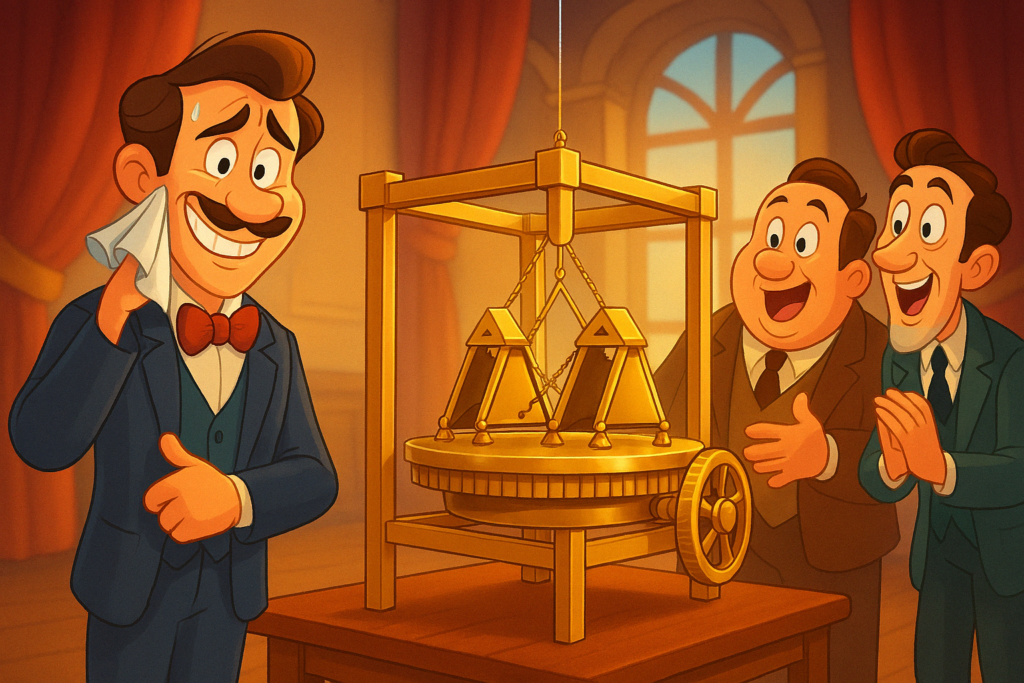
In 1812, Charles Redheffer unveiled what he claimed was an amazing perpetual motion machine in Philadelphia.
Crowds flocked to see this miracle of engineering that seemed to operate continuously without any external power source.
Investors threw money at him. The city nearly granted him $10,000 (about US $240,000 today) to develop his invention.
There was just one problem.
It was a FAKE.
When inspectors demanded to examine the machine more closely, they discovered a hidden cord running to an attic where an old man sat, manually cranking a secondary mechanism.
Redheffer had fooled everyone — including, some historians believe, himself. He was SO invested in his vision that he’d created elaborate self-deceptions to maintain his belief in his own genius.
I call this “Redheffer Syndrome,” and I see it pop up frequently in product development.
A founder becomes so emotionally attached to their creation that they develop blind spots the size of Texas.
They downplay weaknesses, ignore competitors, and vastly overstate benefits.
They drown in their own Kool-Aid.
I once worked with a brilliant food scientist who’d developed what he believed was a revolutionary ingredient. His lab results were stunning. Investors jumped in. Some of the world’s largest food companies were interested.
I believed in it, and joined his team to present on a trade mission to China. We pitched the product to enthusiastic buyers in three different cities.
But independent testing could never replicate his results. Not even close.
The problem wasn’t fraud, at least not in any deliberate sense. This scientist genuinely believed in his invention.
He had full-blown Redheffer Syndrome. It was heartbreaking to witness his anguished disbelief as the results came in.
That’s what made it so compelling to everyone else. His conviction was unshakable, but his objectivity was non-existent.
In I Need That, I discuss how the product maker’s enthusiasm can become their biggest liability.
When you fall in love with your own solution, you stop seeing it clearly.
The dog brain (our emotional center) isn’t limited to influencing customers. It’s influencing YOU as you develop your product. It wants to protect your ego, justify your investment, and maintain your self-image as a visionary.
It’s setting you up for disappointment and eventual damage to your reputation.
So how do you avoid Redheffer Syndrome?
- Seek disconfirming evidence. It’s hard, but you’ve got to actively look for reasons your product might fail. If you find yourself dismissing criticisms without investigation, that’s a red flag. Open your mind.
- Insist on blind testing. Remove your involvement from the evaluation process. If your product TRULY works, it will perform regardless of whether you are in the room adjusting things. (Or some old man is in the attic.)
- Create an “anti-champion” on your team. Give someone the explicit role of poking holes in your assumptions. Reward them for finding flaws, not for cheerleading. Each found flaw is an opportunity to make the product even more awesome.
- Pay attention to reluctance. When someone hesitates to give feedback, or uses softened language, they’re often holding back criticism. Don’t be relieved. Dig deeper.
- Celebrate failures as learning. When tests don’t go as expected, treat it as valuable data, not a setback to overcome or explain away.
Product Payoff: Accounting software giant Intuit has built a company culture around what they call “customer-driven innovation.” Their process requires that team members directly observe customers using prototypes without intervention or explanation. This disciplined approach to removing creator bias has helped them consistently develop successful products across multiple categories, from TurboTax to QuickBooks to Mint. By deliberately taking the creators’ hands off the steering wheel during testing, they’ve built a $160+ billion company.
Action for today: Find one important aspect of your product that you’ve never seen truly independent feedback on. Create a simple blind test where users interact with your product without you present, without priming, and without your explanation of how to use it.
Record the results and commit to accepting them at face value — even (especially) if they contradict your assumptions.
Have you experienced sudden moments of realization about blind spots in your product development? Or worked with someone who exhibited symptoms of Redheffer Syndrome?
Tap that totally legit reply arrow and share your story.
Or reach out to my amazing team of product validation specialists at Graphos Product.
